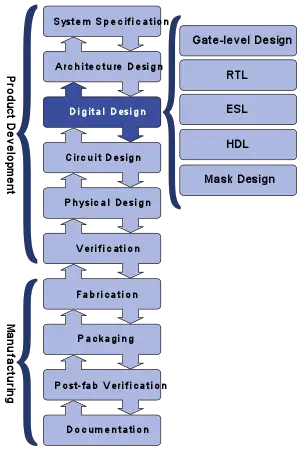From WikiChip
Difference between revisions of "digital design"
m (Inject moved page Digital design to digital design) |
|||
| Line 2: | Line 2: | ||
'''Digital design''' is a sub-discipline within [[computer engineering]] in which specifications and other forms of abstract circuit behavior is turned into a design implementation. Digital design is one of the steps within the standard design cycle of computers and [[Integrated circuit|ICs]]. Traditionally, digital design dealt with [[Logic gate|gate]]-level design ([[register-transfer level]]), synthesis of HDLs (such as [[VHDL]] and [[Verilog]]), and [[IC layout]]. More recently, digital design has grown to included small [[microcontrollers]], [[programmable logic device|PLDs]] and [[soft processors]]. | '''Digital design''' is a sub-discipline within [[computer engineering]] in which specifications and other forms of abstract circuit behavior is turned into a design implementation. Digital design is one of the steps within the standard design cycle of computers and [[Integrated circuit|ICs]]. Traditionally, digital design dealt with [[Logic gate|gate]]-level design ([[register-transfer level]]), synthesis of HDLs (such as [[VHDL]] and [[Verilog]]), and [[IC layout]]. More recently, digital design has grown to included small [[microcontrollers]], [[programmable logic device|PLDs]] and [[soft processors]]. | ||
| − | [[Category: | + | [[Category:digital design]] |
Latest revision as of 12:10, 21 July 2018
Digital design is a sub-discipline within computer engineering in which specifications and other forms of abstract circuit behavior is turned into a design implementation. Digital design is one of the steps within the standard design cycle of computers and ICs. Traditionally, digital design dealt with gate-level design (register-transfer level), synthesis of HDLs (such as VHDL and Verilog), and IC layout. More recently, digital design has grown to included small microcontrollers, PLDs and soft processors.
